1992 VOLKSWAGEN CARAVELLE door lock
[x] Cancel search: door lockPage 5 of 164

Downloaded from www.Manualslib.com manuals search engine
CONTENTS
DASHBOARD AND
CONTROLS
Layout
4
i\='-:ng
lamps 6
CONTROLS
AND
EQUIPMENT
•
e.s. Central locking system 7, 8
I:cs, Tailgate 9, 10
I'I
~g doors 11
..
-^ows, Mirrors 12, 13
Sea: belts 15 5re:y for children 18
-ead restraints 19
Seats
20 _:ariing/sleeping surface 26
__ggage
compartment cover 27 __cgage compartment/load surface ... 28
-edals, Brakes 29 Vanual gearbox 31
--tomatic gearbox 32
gnition
lock 36
Starting / Stopping the engine .... 37, 38 "struments 40
.'.
arning lamps 47
Switches 50
~yn signal and dip lever 52
3'uise
control system 53 .'.'indscreen wiper 54
-eating and ventilation 55
Air
conditioner 57
Recirculating air switch 61
Auxiliary heater 63
Additional
water heater 67
Sun roof, Sliding/tilting roof 70, 71
nterior lights, Sun visors 72, 73
Ashtray, Cigarette lighter 73
-oof
rack 75
DRIVING
TIPS
The first 1500 km - and afterwards ... 76 Driving safely 78
Driving economically and
ecologically
79
Trailer towing 81
GENERAL
MAINTENANCE
Filling the tank, Fuel 85, 86
Care of car, Maintenance 88, 93 Bonnet, Engine compartment 94, 95
Engine oil, Gearbox oil 96, 99
Air
cleaner 100 Power assisted steering 100
Cooling
system 101
Brake fluid 104
Battery 106
Windscreen washer system 108
Wheels 110
Arduous operating conditions 115
Winter driving 116
Accessories, modifications and
renewal of parts 117
Mobile
telephones and two way
radios 117
DO-IT-YOURSELF
First
aid kit, Warning triangle 118
Vehicle tools 118 Spare wheel/changing wheel ... 119, 120
Fuses
122
Changing
bulbs 124
Adjusting/masking headlights .. 128,129
Headlights 129
Installing radio 129
Emergency starting 130
Tow starting/towing 132
Lifting vehicle 134
TECHNICAL
DESCRIPTION
Engine 136
Emission control system 137
Activated charcoal filter '38 Power flow '39
Steering, Axles 139 Brakes, Body -139,
1
AC
Environment compatibility 140
TECHNICAL
DATA
Engine 141
Performance 142
Fuel consumption 143
Spark plugs 145
V-belts 145
Wheels,
Tyre
pressures 146, 147
Weights,
Trailer weights 148, 151 Dimensions 152
Capacities 153
Vehicle identification data 154
SPECIAL
INFORMATION
Adjusting the brake pressure regulator 155
ALPHABETICAL
INDEX
Alphabetical index 156
CHECKS
WHEN
FILLING
THE TANK
Overview 160
3
www.vwT4camper.info - a useful website for owners and enthusiasts of VW T4 Transporter Campervans
Page 10 of 164
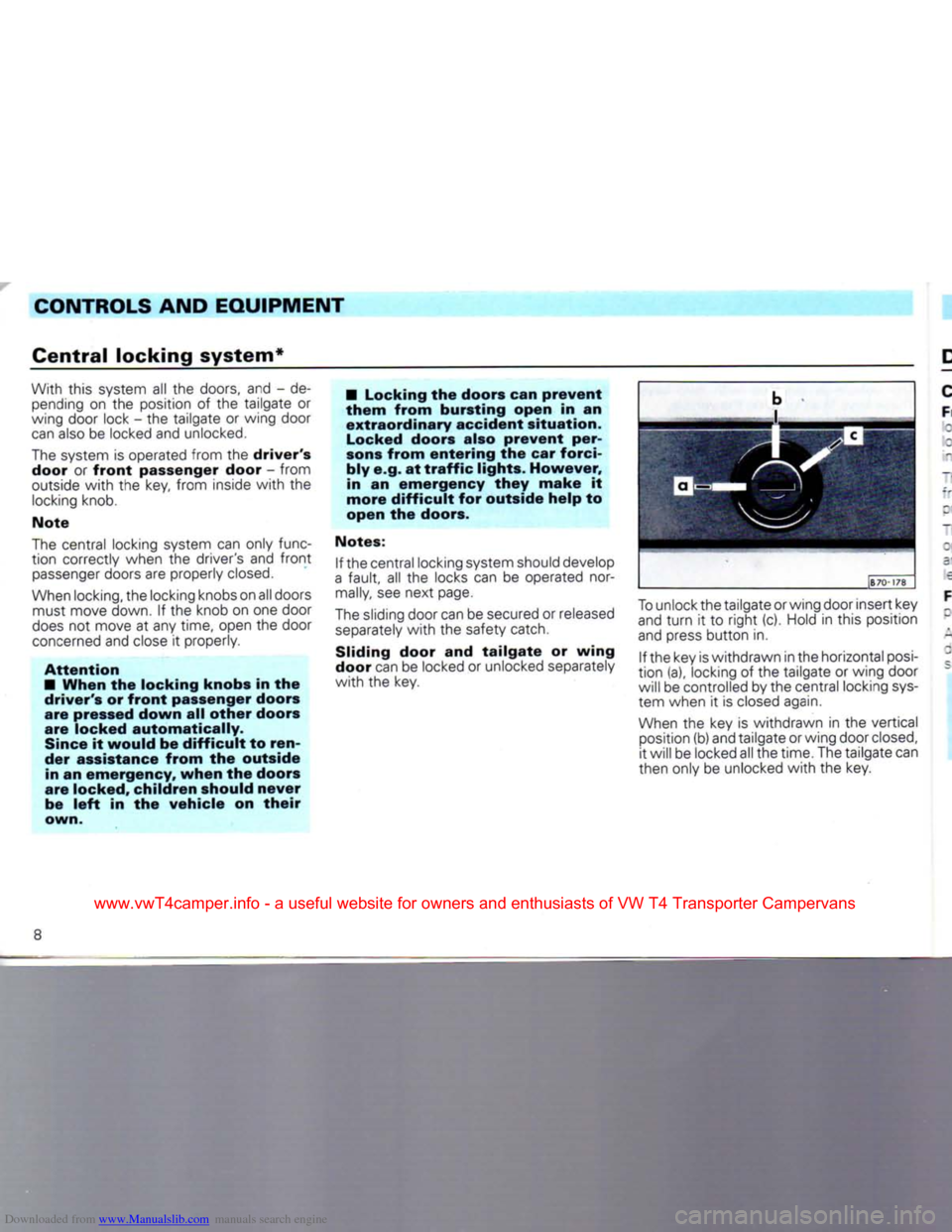
Downloaded from www.Manualslib.com manuals search engine
CONTROLS
AND EQUIPMENT
Central
locking system*
With this system all the doors, and - de
pending
on the position of the tailgate or
wing door lock - the tailgate or wing door
can
also be locked and unlocked.
The
system is operated from the
driver's
door or
front
passenger door - from
outside
with the key, from inside with the
locking
knob.
Note
The
central locking system can only func
tion correctly when the driver's and
front
passenger
doors are properly
closed.
When
locking,
the locking knobs on all doors must move down. If the knob on one door
does
not move at any time, open the door
concerned
and close it properly.
Attention
•
When
the locking knobs in the
driver's
or
front
passenger doors
are pressed
down
all
other
doors
are locked
automatically.
Since it
would
be
difficult
to ren
der assistance
from
the outside in an emergency,
when
the doors
are locked, children should
never
be
left
in the vehicle on
their
own. • Locking the doors can
prevent
them
from
bursting open in an
extraordinary
accident situation. Locked doors also
prevent
per
sons
from
entering
the car forci bly e.g. at
traffic
lights.
However,
in an emergency
they
make
it
more
difficult
for outside
help
to
open the doors.
Notes: If the central locking system should develop
a
fault, all the locks can be operated nor
mally,
see next page.
The
sliding door can be secured or released
separately
with the safety catch.
Sliding door and
tailgate
or
wing
door can be locked or unlocked separately
with the key.
To
unlock the tailgate or wing door insert key
and
turn
it to right (c). Hold in this position
and
press button in.
If the key is withdrawn in the horizontal
posi
tion (a), locking of the tailgate or wing door
will be controlled by the central locking
sys
tem when it is closed again.
When
the key is withdrawn in the vertical
position (b) and tailgate or wing door
closed,
it will be locked all the time. The tailgate can
then only be unlocked with the key.
8
www.vwT4camper.info - a useful website for owners and enthusiasts of VW T4 Transporter Campervans
Page 11 of 164
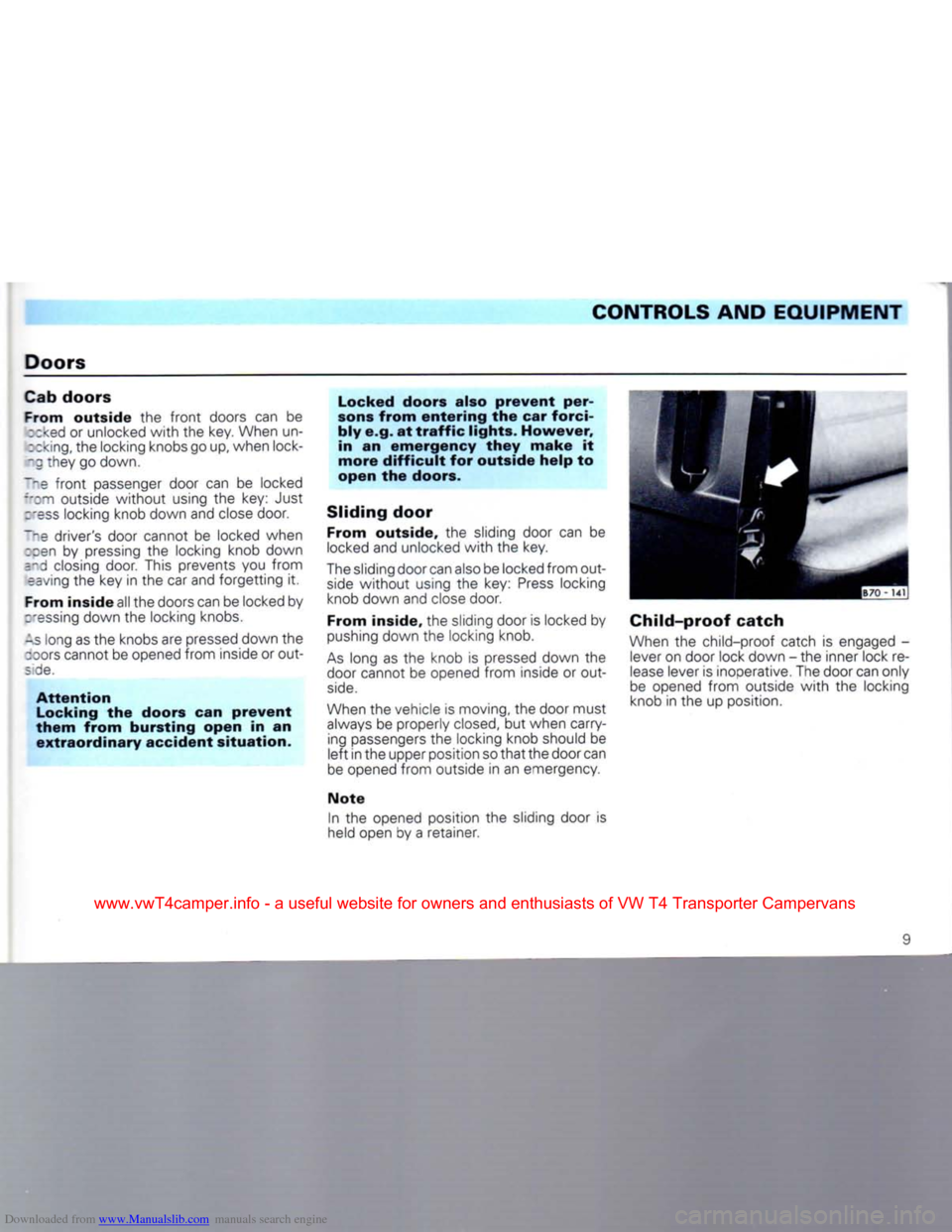
Downloaded from www.Manualslib.com manuals search engine
CONTROLS AND
EQUIPMENT
Doors
Cab doors
From outside
the
front
doors can be
coked
or unlocked
with
the key. When un-
D
eking,
the locking knobs go up, when lock-
"5
:hey go down.
Ihe
front
passenger door can be locked
from
outside
without
using the key: Just
:"5ss
locking knob down and close door.
~~e
driver's door cannot be locked when
coen
by pressing the locking knob down
and closing door. This prevents you from
esving
the key in the car and forgetting it.
From inside
all the doors can be locked by
messing
down the locking knobs.
-s
long as the knobs are pressed down the
coors
cannot be opened from inside or out-
skte.
Attention Locking
the
doors
can
prevent
them from bursting open
in an
extraordinary accident situation. Locked doors also prevent per
sons from entering
the car
forci
bly e.g.
at
traffic lights. However,
in
an
emergency they make
it
more difficult
for
outside help
to
open
the
doors.
Sliding door
From outside,
the sliding door can be
locked
and unlocked
with
the key.
The sliding door can also be locked from out
side
without
using the key:
Press
locking knob down and close door.
From inside,
the sliding door is locked by
pushing down the locking knob.
As
long as the knob is pressed down the
door cannot be opened from inside or out
side.
When the vehicle is moving, the door must always be properly
closed,
but when carrying passengers the locking knob should be
left
in the upper position so
that
the door can
be opened from outside in an emergency.
Note
In the opened position the sliding door is
held open by a retainer. Child-proof
catch
When the child-proof catch is engaged - lever on door lock down - the inner lock re
lease
lever is inoperative. The door can only
be opened from outside
with
the locking
knob in the up position.
9
www.vwT4camper.info - a useful website for owners and enthusiasts of VW T4 Transporter Campervans
Page 13 of 164

Downloaded from www.Manualslib.com manuals search engine
CONTROLS
AND
EQUIPMENT
Wing
doors*
Righthand
door
From
outside
the wing door can be rcked and unlocked with the key. When un-
;cking the locking knob goes up, when
:eking it goes down.
From
inside
the door is locked by pressing down the knob.
-s
long as the knob is pressed down the
;3or
cannot be opened from inside or out.
- the fully open position (approx. 90°) the
;cor is held by a check strap.
Lefthand
door
The lefthand door can be opened when the righthand door is open.
To open, pull release lever (see illustration) and open door.
Note
When
closing
the
wing
doors
always
ensure
that
the
left
door
is
closed
first.
Unhooking
door
check
strap
Both doors are held in the open position (ap
prox. 90°) by check straps.
To open the doors further the check strap can be unhooked (see illustration).
When doors are closed the check straps en gage again automatically.
www.vwT4camper.info - a useful website for owners and enthusiasts of VW T4 Transporter Campervans
Page 19 of 164
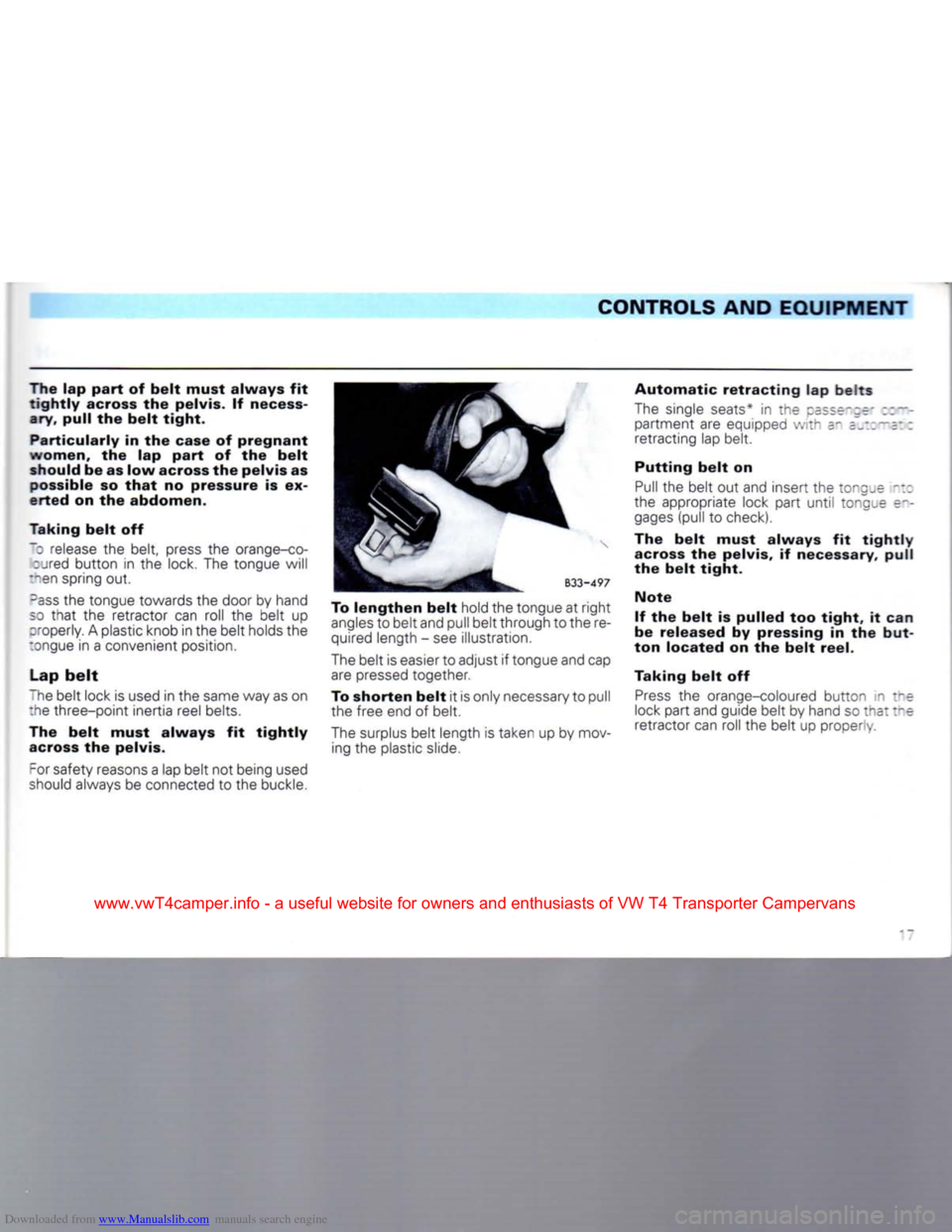
Downloaded from www.Manualslib.com manuals search engine
CONTROLS AND EQUIPMENT
The lap part of belt must always fit tightly across the pelvis. If necess
ary,
pull the belt tight.
Particularly in the case of pregnant
women,
the lap part of the belt should be as low across the pelvis as
possible so that no pressure is ex
erted on the abdomen.
Taking belt off
K release the belt, press the orange-co- :_red button in the lock. The tongue will
"en spring out.
-ass the tongue towards the door by hand
so that the retractor can roll the belt up
oroperly. A plastic knob in the belt holds the
:ongue in a convenient position.
Lap belt
The belt lock is used in the same way as on the three-point inertia reel belts.
The belt must always fit tightly across the pelvis.
For safety reasons a lap belt not being used
should always be connected to the buckle. To lengthen belt hold the tongue at right
angles to belt and pull belt through to the re
quired length - see illustration.
The belt is easier to adjust if tongue and cap are pressed together.
To shorten belt it is only necessary to pull
the free end of belt.
The surplus belt length is taken up by mov ing the plastic slide. Automatic retracting lap
beits
The single seats* in the ca;;e-;e'
;im
pertinent are equipped with =- —5; ;
retracting lap belt.
Putting belt on
Pull the belt out and insert the tors_e ~:
the appropriate lock part until tongue en gages (pull to check).
The belt must always fit tightly across the pelvis, if necessary,
pull
the belt tight.
Note
If the belt is pulled too tight, it can
be released by pressing in the
but
ton located on the belt reel.
Taking belt off
Press the orange-coloured button in the
lock part and guide belt by hand sc :na: :~s
retractor can roll the belt up properly.
www.vwT4camper.info - a useful website for owners and enthusiasts of VW T4 Transporter Campervans
Page 23 of 164
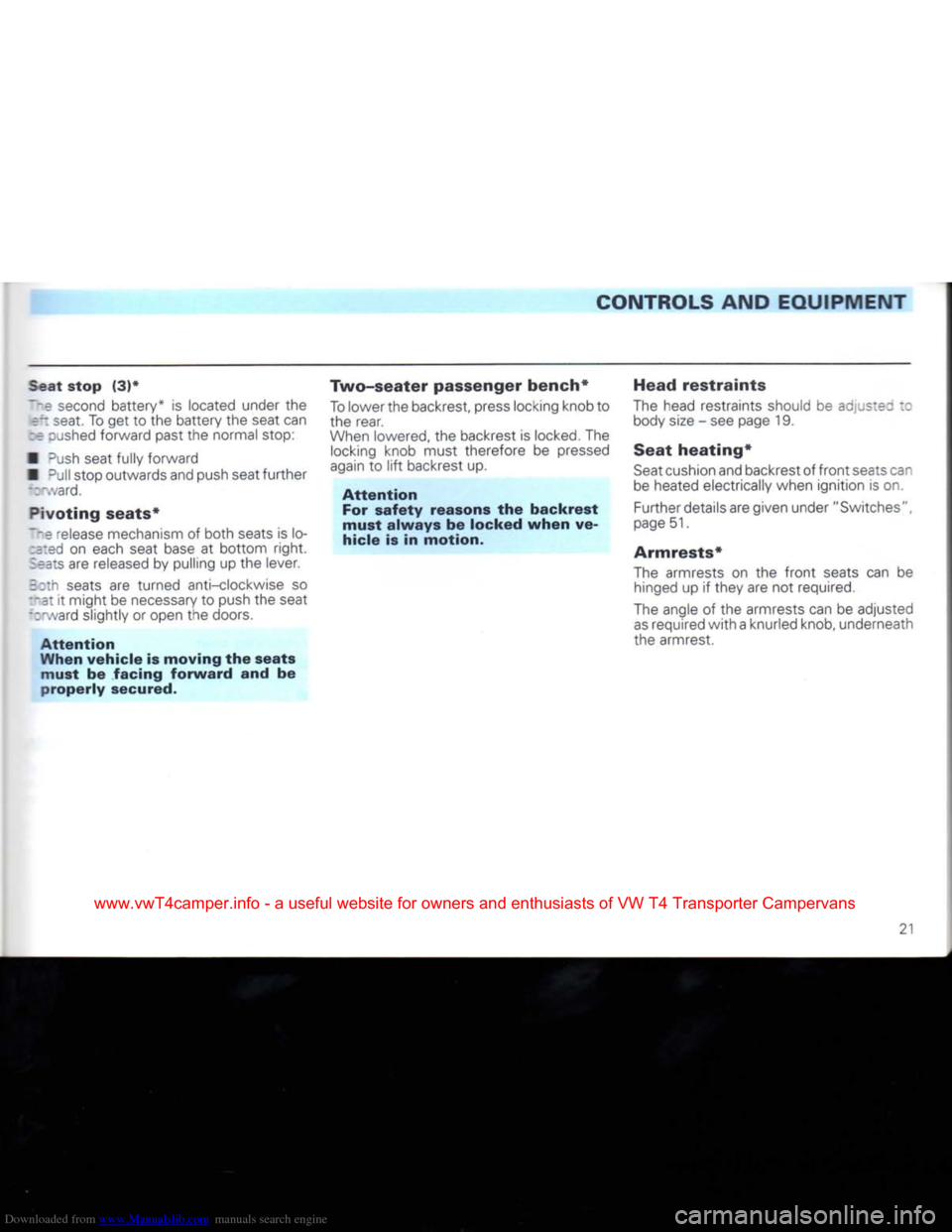
Downloaded from www.Manualslib.com manuals search engine
CONTROLS AND
EQUIPMENT
Seat
stop
(3)*
the second battery* is located under the •ft seat. To get to the battery the seat can
:e
cashed forward past the normal stop:
• Dush seat fully forward
• Dul stop outwards and push seat
further
":~.vard.
Pivoting
seats*
me release mechanism of both seats is lo rded on each seat base at bottom
right.
Seats
are released by pulling up the lever.
E::^
seats are turned anti-clockwise so
:~at it might be necessary to push the seat
':".vard slightly or open the doors.
Attention
When
vehicle
is
moving
the
seats
must
be
facing
forward
and be
properly
secured.
Two-seater
passenger bench*
To
lower the backrest, press locking knob to
the rear.
When lowered, the backrest is locked. The locking knob must therefore be pressed
again to
lift
backrest up.
Attention
For
safety
reasons the
backrest
must
always
be locked
when
ve
hicle
is in
motion.
Head
restraints
The head restraints should be ac _s:e; body
size
- see page 19.
Seat
heating*
Seat
cushion and backrest of
front
seats can
be heated electrically when ignition is on. Further details are given under "Switches",
page 51.
Armrests*
The armrests on the
front
seats can be hinged up if they are not required.
The angle of the armrests can be adjusted
as
required
with
a knurled knob, underneath
the armrest.
2!
www.vwT4camper.info - a useful website for owners and enthusiasts of VW T4 Transporter Campervans
Page 112 of 164
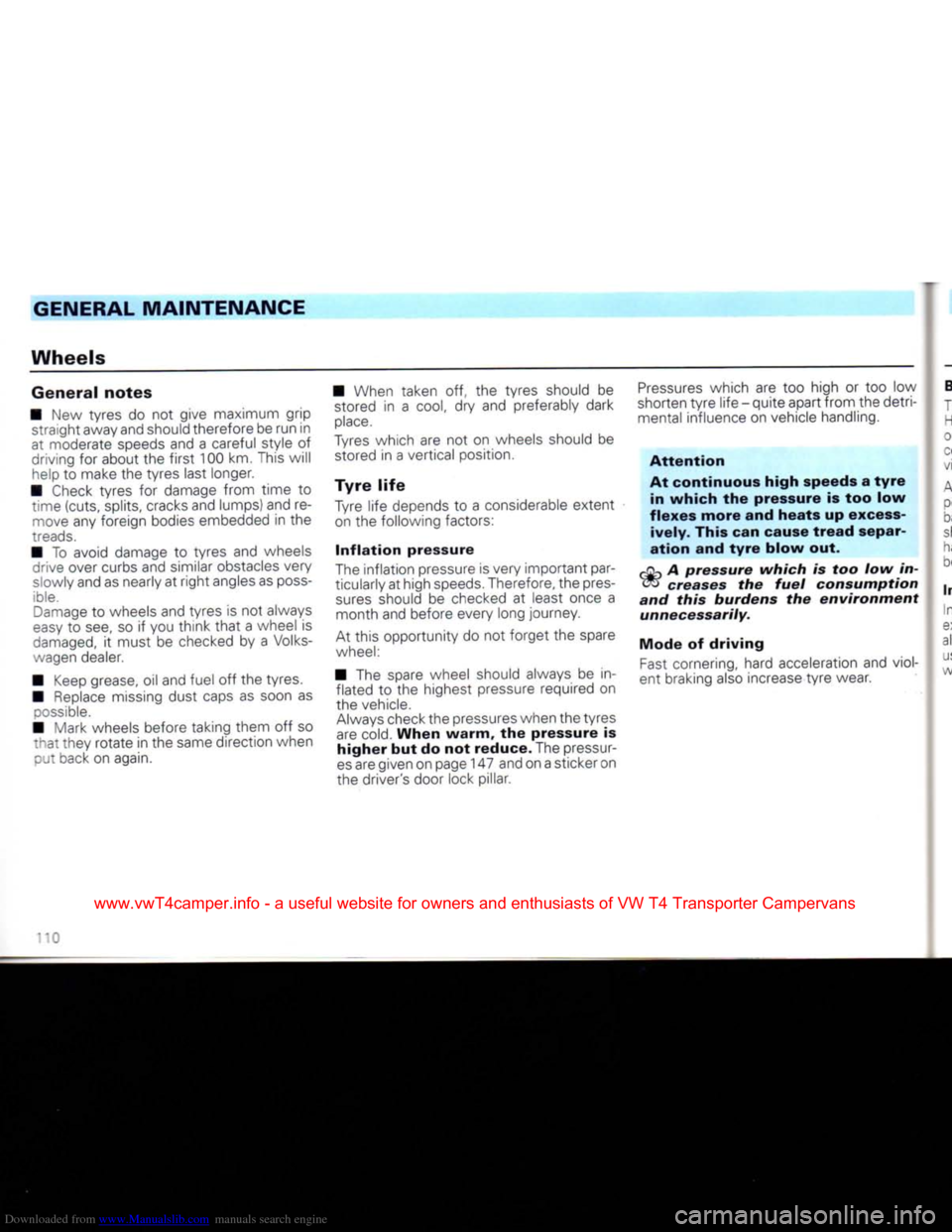
Downloaded from www.Manualslib.com manuals search engine
GENERAL
MAINTENANCE
Wheels
General
notes
• New tyres do not give maximum grip straight away and should therefore be run in
at moderate speeds and a careful style of
driving for about the
first
100 km. This will help to make the tyres last longer.
• Check tyres for damage from time to time (cuts, splits, cracks and lumps) and remove any foreign bodies embedded in the
treads.
• To avoid damage to tyres and wheels crive over curbs and similar obstacles very
slowly and as nearly at
right
angles as
poss
ible.
Damage
to wheels and tyres is not always
easy
to see, so if you
think
that
a wheel is
damaged,
it must be checked by a Volks
wagen dealer.
• Keep grease, oil and fuel off the tyres.
• Replace missing dust caps as soon as
possible.
• Mark wheels before taking them off so
that
they rotate in the same direction when put back on again. • When taken off, the tyres should be
stored in a
cool,
dry and preferably dark
place.
Tyres
which are not on wheels should be stored in a vertical position.
Tyre
life
Tyre life depends to a considerable extent on the following factors:
Inflation
pressure
The inflation pressure is very important par
ticularly at high
speeds.
Therefore, the pres
sures
should be checked at least once a month and before every long journey.
At this opportunity do not forget the spare
wheel:
• The spare wheel should always be in flated to the highest pressure required on
the vehicle.
Always
check the pressures when the tyres are cold.
When
warm,
the pressure is
higher
but do not
reduce.
The pressur
es
are given on page 147 and on a sticker on
the driver's door lock pillar.
Pressures
which are too high or too low
shorten
tyre
life - quite apart from the detri mental influence on vehicle handling.
Attention
At
continuous
high
speeds a
tyre
in
which
the pressure is too low
flexes
more
and
heats
up excess
ively.
This can cause
tread
separ
ation
and
tyre
blow
out.
pCU
A
pressure
which
is too low in- oo
creases
the
fuel
consumption
and
this
burdens
the
environment
unnecessarily.
Mode
of
driving
Fast
cornering, hard acceleration and viol
ent braking also increase
tyre
wear.
'0
www.vwT4camper.info - a useful website for owners and enthusiasts of VW T4 Transporter Campervans
Page 122 of 164
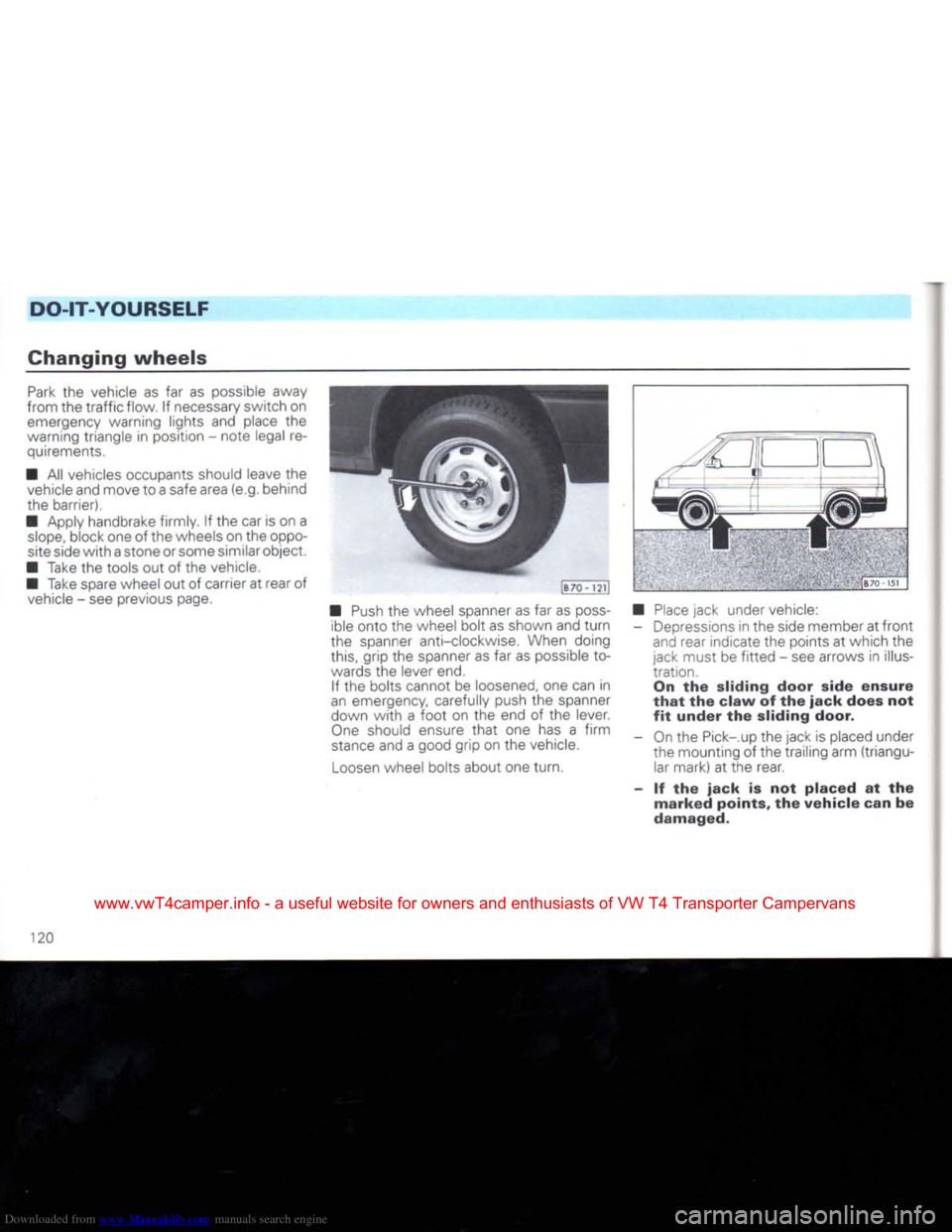
Downloaded from www.Manualslib.com manuals search engine
DO-IT-YOURSELF
Changing
wheels
Park
the vehicle as far as possible away
from the
traffic
flow, if necessary switch on emergency warning lights and place the
warning triangle in position - note legal re
quirements.
• All vehicles occupants should leave the vehicle and move to a safe area (e.g. behind
the barrier).
• Apply handbrake firmly. If the car is on a
slope,
block one of the wheels on the oppo
site side
with
a stone or some similar object.
• Take the tools out of the vehicle.
• Take spare wheel out of carrier at rear of vehicle - see previous page.
JB70
- 121J
•
Push
the wheel spanner as far as
poss
ible onto the wheel bolt as shown and
turn
the spanner anti-clockwise. When doing this, grip the spanner as far as possible to
wards the lever end.
If the bolts cannot be loosened, one can in
an emergency, carefully push the spanner
down
with
a
foot
on the end of the lever.
One
should ensure
that
one has a
firm
stance
and a good grip on the vehicle.
Loosen
wheel bolts about one turn. 8"" 1 •>!
•
Place
jack under vehicle: - Depressions in the side member at
front
and rear indicate the points at which the
jack must be
fitted
- see arrows in illus
tration. On the sliding door side
ensure
that
the
claw
of the
jack
does not
fit
under
the sliding door.
- On the Pick-.up the jack is placed under the mounting of the trailing arm (triangular mark) at the rear.
- If the
jack
is not
placed
at the
marked
points, the
vehicle
can be
damaged.
120
www.vwT4camper.info - a useful website for owners and enthusiasts of VW T4 Transporter Campervans